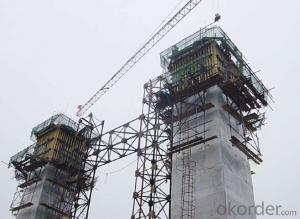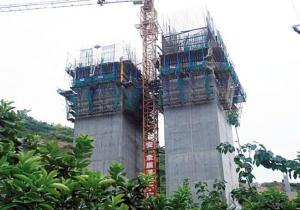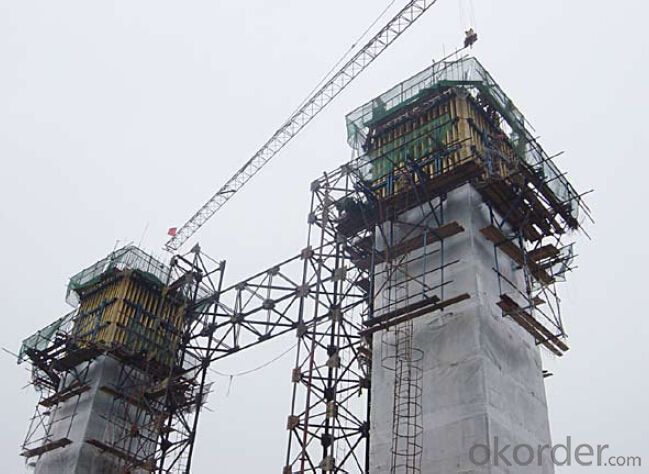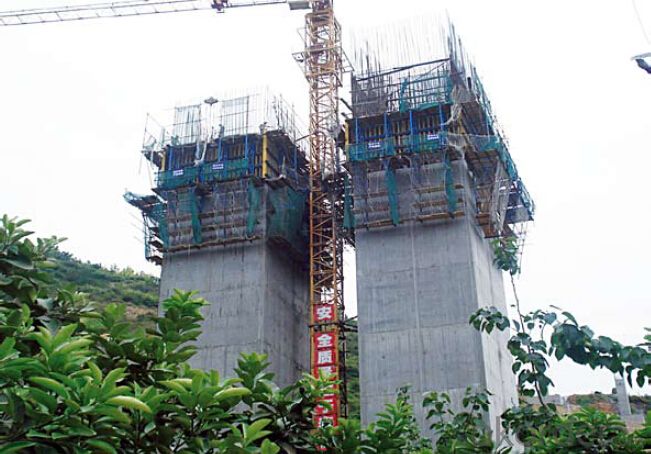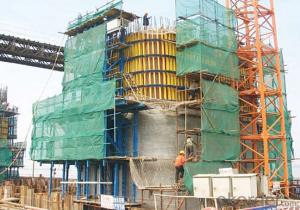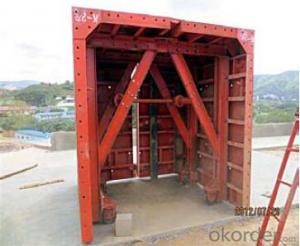Climbing Bracket for Formwork and Scaffolding Build
- Loading Port:
- Tianjin
- Payment Terms:
- TT OR LC
- Min Order Qty:
- 50 m²
- Supply Capability:
- 1000 m²/month
OKorder Service Pledge
OKorder Financial Service
You Might Also Like
Climbing Bracket CB240 & CB210
They are framework brackets for supporting large-area wall formwork.
Typical applications for the CB240&CB210 are pier and column/shear wall/core walll/ in the
building.
CB210 has smaller size than CB240, it will be cost effective in some condition.
Characteristics:
◆ High bearing capacity
The high loading capacity of the brackets allow very large scaffold units. This saves the number
anchor points required as well as reducing climbing times.
◆ Simple moving procedure by crane
Through the strong connection of formwork together with the climbing scaffold, both can be moved
as a single climbing unit by crane. Thus valuable time-savings can be achieved.
◆ Fast striking process without a crane
With the retrusive set, large formwork elements can also be retracted quickly and a minimum of
effort.
◆ Safe with work platform
The platforms have assembled firmly with bracket and will be climbing together, without scaffolding
but can work safely in spite of your high location.
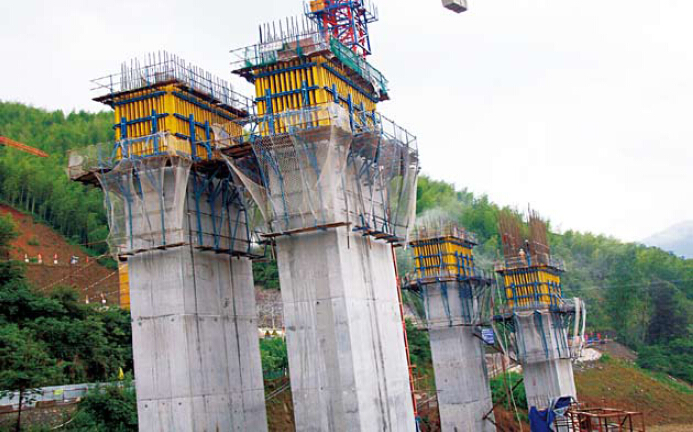
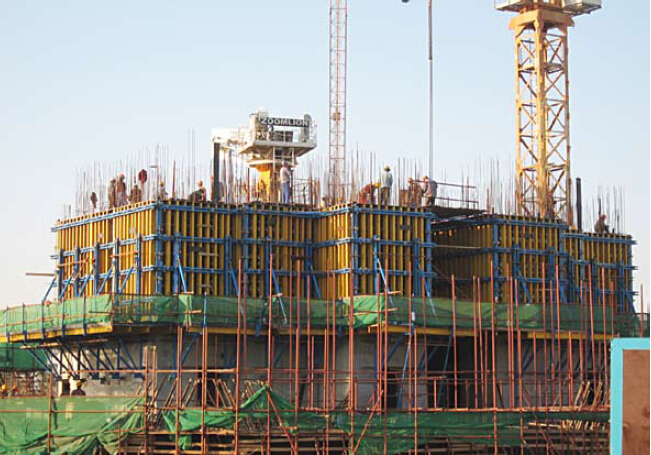
- Q: How does steel formwork affect the overall project timeline?
- The overall project timeline can be significantly influenced by steel formwork. The durability and reusability of steel formwork are among its main advantages. Unlike traditional timber formwork, steel formwork can endure multiple uses and can be easily assembled and disassembled. As a result, construction times are expedited since the formwork can be quickly set up and reused on various parts of the project. Additionally, steel formwork offers a higher level of precision and accuracy, ensuring that the concrete structures are constructed according to exact specifications. This eliminates the need for rework or adjustments, saving time and resources. The use of steel formwork also accelerates concrete curing times as the steel panels provide better insulation and heat retention. Moreover, steel formwork is renowned for its strength and stability, reducing the risk of accidents and delays during the construction process. Its robustness allows for the pouring of larger concrete sections at once, boosting productivity and minimizing the number of pour cycles required. However, it is important to note that while steel formwork expedites the construction process, it necessitates additional planning and coordination. The design and fabrication of steel formwork should be completed well in advance to ensure it aligns with the project timeline. Any modifications or adjustments to the formwork design must also be carefully managed to prevent disruptions to the overall schedule. In conclusion, steel formwork positively impacts the overall project timeline through its durability, reusability, precision, faster curing times, and increased productivity. Nonetheless, careful planning and coordination are crucial to maximize the benefits of steel formwork while minimizing potential delays.
- Q: How does steel formwork handle formwork stripping and repositioning?
- Steel formwork is an option that is highly durable and versatile for the handling of formwork stripping and repositioning. It is designed to withstand the pressure exerted during the concrete pouring process and can easily manage the removal of the formwork once the concrete has set. When it comes to the removal of formwork, steel formwork offers several advantages. Firstly, it ensures a high-quality end result by providing a smooth surface finish to the concrete. The steel panels are typically coated with a protective layer, preventing concrete from sticking to the formwork and making stripping easier. The steel formwork system is engineered to facilitate quick and efficient formwork removal. This is achieved through the use of various mechanisms such as wedge clamps, pins, or hooks, which securely hold the formwork panels in place during the pouring process. Once the concrete has gained sufficient strength, these mechanisms can be easily released, allowing for smooth and effortless stripping of the formwork. Furthermore, steel formwork can be easily repositioned and reused for multiple construction projects. The modular design of steel panels allows for flexibility in adjusting the formwork to different dimensions and shapes. This reusability significantly reduces the overall cost of formwork, making it a cost-effective solution for construction projects. In addition, steel formwork provides excellent strength and stability, ensuring the integrity of the structure throughout the formwork stripping and repositioning process. This is particularly crucial in high-rise or complex structures where the formwork must withstand significant loads and pressures. In conclusion, steel formwork is a dependable and efficient choice for handling formwork stripping and repositioning. Its durability, ease of use, and adaptability make it the preferred option for construction projects of various sizes and complexities.
- Q: How does steel formwork handle formwork stripping and cleaning?
- Steel formwork handles formwork stripping and cleaning efficiently due to its durability and strength. It can withstand the pressure and force exerted during the stripping process without getting damaged. Additionally, steel formwork is easy to clean as it has a smooth surface, allowing for quick and thorough removal of any residual concrete or dirt. Its robust nature and low maintenance requirements make it a preferred choice for formwork stripping and cleaning in construction projects.
- Q: What are the different types of accessories available for steel formwork?
- Steel formwork offers a range of accessories designed to improve the efficiency and effectiveness of the system. Several common types of accessories include: 1. Clamps - These securely connect formwork panels, providing stability and preventing movement during concrete pouring. 2. Wedges - These level and align the panels by inserting them between the panels and tightening for a secure fit. 3. Ties - Made of steel, these secure formwork panels to the structure by inserting them through panel holes and anchoring them. 4. Connectors - These join panels at corners or junctions, maintaining the formwork system's structural integrity. 5. Spacers - These maintain a specific distance between panels, ensuring the desired concrete thickness. 6. Brackets - These support formwork panels during construction, preventing sagging or bending. 7. Release agents - Applied to panels before pouring concrete, these prevent adhesion, allowing for easy removal once the concrete sets. 8. Handles - These facilitate handling and positioning of panels, providing a secure grip for proper placement. 9. Chamfers - These create beveled edges on concrete, attached to panels for a finished look. 10. Accessories for special applications - Specialized accessories exist for curved structures, columns, and beams. These examples highlight the range of accessories available for steel formwork. The choice of accessories depends on project requirements and desired outcomes. Selecting the appropriate accessories is crucial for a successful and efficient formwork system.
- Q: Can steel formwork be used for both vertical and horizontal concrete structures?
- Yes, steel formwork can be used for both vertical and horizontal concrete structures. Steel formwork is highly versatile and can be easily adjusted and assembled to create various shapes and sizes for different structures. It provides strong support, stability, and durability, making it suitable for both vertical walls and horizontal slabs. Steel formwork also offers excellent dimensional accuracy, ensuring precise concrete placement and alignment. Additionally, steel formwork is reusable, which makes it a cost-effective option for construction projects that require repetitive use of formwork systems.
- Q: How does steel formwork affect the cost of construction?
- Steel formwork can have a significant impact on the overall cost of construction. While it may require a higher initial investment compared to traditional formwork materials such as wood or plywood, steel formwork offers several advantages that can help offset the increased cost. Firstly, steel formwork is incredibly durable and long-lasting, which means it can be reused multiple times. Unlike wood or plywood formwork, steel formwork does not warp, rot, or degrade over time. This reusability factor reduces the need for frequent formwork replacements, thus saving on material costs in the long run. Additionally, steel formwork provides superior strength and stability, allowing for the construction of complex and high-quality concrete structures. This strength enables the use of thinner formwork elements, reducing the overall weight of the formwork system. As a result, less labor and equipment are required for handling and installation, leading to cost savings in terms of manpower and machinery. Furthermore, steel formwork allows for faster construction cycles. The smooth and precise surface finish provided by steel formwork reduces the need for extensive finishing work. This streamlined construction process saves time, ultimately reducing labor costs and project timelines. Moreover, steel formwork offers enhanced safety on construction sites. Its sturdy nature and secure connections ensure stability during concrete pouring and curing, minimizing the risk of accidents or structural failures. This improved safety aspect can help in reducing insurance costs and potential legal liabilities. Lastly, steel formwork is highly adaptable and customizable. It can be easily modified and adjusted to accommodate various design requirements, making it suitable for a wide range of construction projects. This flexibility helps optimize material usage and ensures minimal wastage, thereby reducing overall construction costs. In summary, although steel formwork may initially incur a higher cost, its long-term benefits such as reusability, strength, speed, safety, and adaptability contribute to overall cost savings in construction projects. Its durability and efficiency make it a cost-effective choice that can positively impact the quality, timeline, and budget of any construction undertaking.
- Q: Are there any specific safety guidelines for steel formwork installation?
- Yes, there are specific safety guidelines for steel formwork installation. These guidelines include ensuring proper training and supervision of workers, using appropriate personal protective equipment, inspecting the formwork for any defects or damage before installation, following proper lifting and handling techniques, and securing the formwork to prevent collapse or displacement. Additionally, adherence to local building codes and regulations is crucial for maintaining safety during steel formwork installation.
- Q: Can steel formwork be used for tunnel construction?
- Yes, steel formwork can be used for tunnel construction. Steel formwork refers to the temporary or permanent molds made from steel that are used to shape and support concrete during the construction process. In tunnel construction, steel formwork is commonly used to create the tunnel lining, which provides structural support and protects the tunnel from external forces. Steel formwork offers several advantages for tunnel construction. Firstly, it is strong and durable, capable of withstanding the pressures and forces exerted on the tunnel structure. This makes it suitable for constructing tunnels in various ground conditions, including soft soils, rock, or even underwater. Secondly, steel formwork can be easily customized to the required shape and size, allowing for flexibility in tunnel design. It can be prefabricated off-site and then assembled on-site, reducing construction time and costs. Additionally, steel formwork is reusable, which further enhances its cost-effectiveness and sustainability. Furthermore, steel formwork provides a smooth and high-quality finish to the tunnel lining, ensuring the structural integrity and longevity of the tunnel. It also allows for the easy installation of other tunnel components, such as electrical conduits, ventilation systems, and drainage pipes. However, it is important to note that the selection of formwork material depends on various factors, including tunnel dimensions, construction method, ground conditions, and project requirements. Other types of formwork materials, such as timber or aluminum, may also be suitable for tunnel construction depending on the specific project needs.
- Q: What are the different components of steel formwork?
- Steel formwork is a type of temporary structure that is used in construction projects to provide support and shape to concrete during the curing process. It consists of several components that work together to create a rigid and durable formwork system. The main components of steel formwork include: 1. Panels: These are the primary components of the formwork system and are usually made of steel or steel-reinforced plywood. They are available in different sizes and shapes and can be easily interconnected to create the desired formwork configuration. 2. Soldiers: These are vertical members that provide support to the formwork panels. They are typically made of steel and are adjustable in height, allowing for flexibility in formwork design. Soldiers are connected to the panels using connecting clamps or pins. 3. Waler Beams: These are horizontal members that help distribute the load evenly across the formwork system. Waler beams are connected to the soldiers using clamps or brackets and are usually made of steel or aluminum. 4. Tie Rods: These are used to hold the formwork panels and soldiers together. They are threaded rods that pass through the panels and are secured with nuts and washers on each side. Tie rods help in maintaining the required spacing between the panels and provide additional strength to the formwork system. 5. Formwork Accessories: These include various components such as clamps, brackets, wedges, and pins that are used to connect and secure the formwork components. They help in maintaining the stability and alignment of the formwork system during concrete pouring and curing. 6. Formwork Joints: These are specially designed connectors that allow for easy assembly and disassembly of the formwork system. They ensure proper alignment and tightness of the formwork components, preventing leakage of concrete and maintaining the desired shape. 7. Formwork Supports: These are used to provide additional support to the formwork system, especially for larger and complex structures. Formwork supports can be in the form of props, scaffolding, or specialized shoring systems, depending on the specific requirements of the project. Overall, these components work together to create a strong and stable formwork system that can withstand the pressure and weight of the concrete during the construction process. Steel formwork is preferred for its durability, reusability, and ease of assembly and disassembly, making it a popular choice in modern construction projects.
- Q: How does steel formwork compare to timber formwork in terms of durability?
- Steel formwork is generally more durable than timber formwork. Steel is a strong and rigid material that can withstand greater loads and pressures compared to timber. It is resistant to warping, rotting, and pest infestations that are common with timber. Additionally, steel formwork has a longer lifespan and requires less maintenance, making it a more durable choice for construction projects.
Send your message to us
Climbing Bracket for Formwork and Scaffolding Build
- Loading Port:
- Tianjin
- Payment Terms:
- TT OR LC
- Min Order Qty:
- 50 m²
- Supply Capability:
- 1000 m²/month
OKorder Service Pledge
OKorder Financial Service
Similar products
Hot products
Hot Searches
